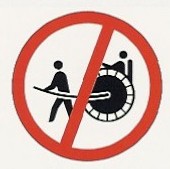
Why no rickshaw? It is like the tongue twister “Rubber buggy baby bumper” coming to me a short while ago while out for a walk. I can’t explain it.
Actually, I just came across the sign while searching for something else. I got the picture, of all places, off the Web site of the South Africa Department of Transportation. It is one of their warning signs. I’ve never been to South Africa. But I never really thought of it as a place with rickshaws. At the very least, I’ve never thought of South Africa as a place with a need for “No Rickshaw” signs. It’s a rather quaint idea to me but it might make perfect sense to someone in South Africa.
I wonder what it would be like to be filthy rich and have your very own rickshaw driver? What would you pay him or her? How would you interview a prospective driver? “Hey take me for a spin around the block.” What would be the speed one would expect a rickshaw driver to run while pulling you somewhere? I just have a lot of questions about rickshaws. That’s all I’m saying.
I would have expected to see rickshaws in the Philippines but I never saw any there. Why would I expect to see rickshaws there? Is it because I think all Asian countries have rickshaws and a never-ending supply of laundry workers? No. It is because the Philippines had some really strange modes of transportation. Like the Jeepneys. They were originally pimped out U.S. military jeeps left over from World War II. Also among the ways to get around when I was in the Philippines were motorcycle sidecars.
Riding a sidecar, or even being around a sidecar, was taking one’s life into their own hands. But then most every taxi ride I had in the Philippines was hair-raising. Perhaps the scariest ride was one I took one afternoon from the Subic Bay Navy Base to the Cubi Point Naval Air Station. The road going to Cubi point was a winding mountain road that had no railings to separate the road from what was quite a large drop-off. As we were riding along in this Toyota Corolla taxi, a monkey ran out in front of us. The driver, being cute I suppose, steered momentarily toward the monkey as if he was going to hit it and laughed. I didn’t find it very funny.
Cubi Point has an interesting history, by the way. According to the official U.S. Navy Seabees history:
“Civilian contractors, after taking one look at the forbidding Zambales Mountains and the maze of jungle at Cubi Point, claimed it could not be done. Nevertheless, the Seabees proceeded to do it! Begun in 1951 at the height of the Korean War, it took five years and an estimated 20-million man-hours to build this new, major Navy base. At Cubi Point Seabees cut a mountain in half to make way for a nearly two-mile long runway. They blasted coral to fill a section of Subic Bay, filled swampland, moved trees as much as a hundred and fifty feet tall and six to eight feet in diameter, and even relocated a native fishing village. The result was an air station, and an adjacent pier that was capable of docking the Navy’s largest carriers.”
I bet it would have been a hell of a ride up the mountain in a rickshaw.
